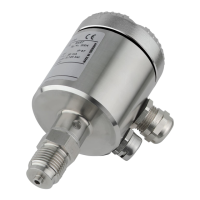261Gx, 261Ax | IM/261Gx/Ax-EN Rev. 08 9
2 Use in potentially explosive
atmospheres
2.1 Explosion protection
Explosion-protection should be conducted in accordance with
Directive 2014/34/EU (ATEX).
When installing explosion-proof transmitters (electrical
connection, grounding / potential equalization, etc.), observe
national regulations, DIN / VDE regulations and explosion-
protection directives.
The certified explosion-proof designation for the transmitter is
provided on the name plate.
2.2 Type-examination certificate/Declaration of
conformity
For transmitters with explosion-proof designs, the EU
declaration of conformity and this operating instruction should
be complied with. The EC type examination certificates to be
applied are available for download online on the ABB website.
2.3 Type of protection "intrinsic safety Ex i"
Only intrinsically safe devices may be installed in the
transmitter signal circuit. The signal circuit can be interrupted
while the transmitter is in operation (e.g., clamping/unclamping
signal lines).
The housing may be opened during operation.
Transmitters with and without remote seals and featuring type
of protection "intrinsic safety Ex i" may be directly integrated
into the partition separating Zone 0 and Zone 1 (sensor
diaphragm in Zone 0, transmitter in Zone1), provided that the
power is supplied via an intrinsically safe circuit with type of
protection "Ex ia".
2.4 Use in areas with combustible dust
Installation should be performed in accordance with the
EN 60079-14 installation regulations.
The transmitter should only be connected using cable glands
certified in accordance with Directive 2014/34/EU (ATEX). The
cable gland must conform to IP rating IP 67.
The smoldering temperature of the dust must be at least 75 K
above the maximum surface temperature of the transmitter.
The maximum surface temperature is 95 °C (203 °F) and is
obtained by adding together the maximum ambient
temperature (85 °C (185 °F)) and the maximum self-heating
(10 K).
WARNING! Risk of explosion!
When using remote seals with an anti-stick
coating, be aware of the risk of electrostatic
discharge (with consideration given to the filling
material and transport speed).
2.5 Category 3 (EPL Gc) with type of protection "nA"
The transmitter must be connected using a certified cable
gland (not included in scope of delivery). The cable gland must
satisfy the requirements of the ‘Increased safety Ex e’ type of
protection in accordance with Directive 2014/34/EU (ATEX).
Additionally, the conditions stipulated in the type-examination
certificate for the cable gland must be observed.
WARNING! Risk of explosion!
Opening the housing during operation (with the
supply voltage switched on) is not permitted.
Opening the cover presents a risk of spark
formation and, therefore, explosion.
Only open the housing when the supply voltage
is switched off.
2.6 Use of handheld terminal / PC
If a handheld terminal or a PC is being used for
communication / configuration / parameterization in a
potentially explosive atmosphere with type of protection
"intrinsic safety", the devices used must be certified
accordingly.
This applies even if the device is only connected for a short
period of time. This proof of "intrinsic safety" must be supplied
in addition to the transmitter.
WARNING! Risk of explosion!
The handheld terminal battery must not be
replaced in a potentially explosive atmosphere.
Replacing the battery presents a risk of spark
formation and, therefore, explosion.
The battery may only be replaced outside of the
potentially explosive atmosphere.

